Topaz
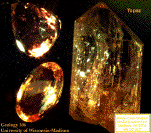
What is topaz?
Where is topaz formed?
Geographic localities
Treatment of topaz
Topaz
| COMPOSITION | Al2SiO4(F,OH)2 |
| HARDNESS | 8 |
| CRYSTAL SYSTEM | ORTHORHOMBIC |
| COLOR | Various (see below) |
| PLEOCHROISM | Light yellow or pink |
| CLEAVAGE | Basal |
| HABIT | Prismatic |
| SPECIFIC GRAVITY | 3.53 |
How are topaz crystals cut?
- crystals: up to 100 lbs in weight !
- world's largest facetable gem (22,982 ct)
- appearance: vitreous (glassy luster)
- color:
- reddish-yellow ("imperial")
- orange-brown ("sherry")
- clear
- blue
- pinkish
- natural and treated blue (see below)

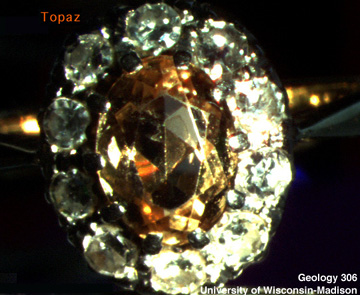
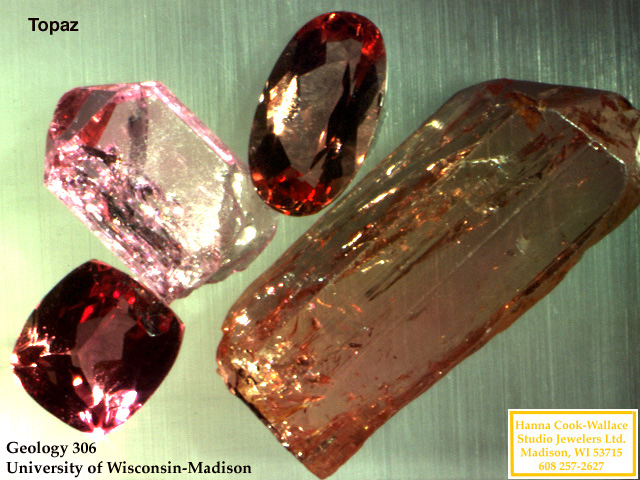
Geologic conditions of formation:
Topaz crystallizes from fluorine-bearing vapor in last stages of solidification of igneous rocks. Thus, cavities in lavas and granitic rocks:- in pegmatites
- in alluvial deposits
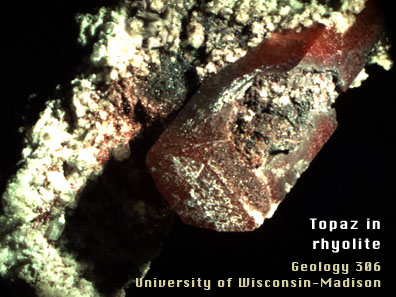
Geographic location:
- Brazil: Ouro Preto and Minas Gerais
- Siberia and the Ural Mnts.
- Pakistan (esp. pink topaz)
- Sri Lanka (esp. irradiated topaz)
Treatments:
Irradiation and Heat TreatmentTopaz is the most common irradiated gem on the market. Particles, or electromagnetic rays (ionizing radiation), have enough energy to produce color centers. High energy particles include:
- electrons
- alpha particles
- beta particles
- gamma particles: Co-60 Gamma Cell
- neutrons
- alpha particles = high speed helium (He) atoms with no electrons
- beta particles = high speed electrons
- gamma rays = high energy photons of electromagnetic radiation (similar to x-rays, but shorter wavelenght and thus, more energetic)
- neutrons = neutral subatomic particles
- Irradiation is most often carried out in Linear accelerators (high energy electrons) and Nuclear reactors (high energy neutrons)
- residual radioactivity potentially a problem. Stone may have to be stored to allow radioactivity to decay (half life may be hours to days)
- Nuclear reactors create an intense blue (that does not need secondary heat treatment)
- gamma rays => brownish greenish color + HEAT (see below) -> steel grey/blue ("cobalt")
- Details:
marketing names: "sky",
"london", "swiss" , "super", "cobalt", "max", etc.
Some examples:
Irradiation is used to change the color of many gems!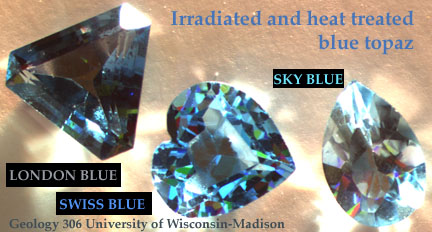
Examples of color manipulation:
Heat only:orange brown Cr-bearing topaz + HEAT (450 C) and cool -> pink-purple (termed 'pinking')
Why ?
- color = sum of: Cr -> pink and a color center -> yellow-brown
- recall, a color center is often an electron trapped in an atomic site, a form of structural damage often caused by radiation
- Heat allows crystal to heal itself and release electron from trap, removing brownish tinge (leaving pink)
topaz irradiation -> greenish brown color (= blue + yellow + reddish tinge)
each of the components of the color is due to a color center. Least stable are the yellow and reddish; controlled heating removes these, leaving blue color centers.
Who cares?
Treatment is controversial because:
- Ready availability of artificial material could swamp out naturally colored material, reducing its value.
- Irradiation can not be detected.
- The color may not be stable; it may change over time.
- safety concerns (rarely a problem)
How does this source compare
with the major sources of radiation exposure to a human being? Continued
next lecture!
